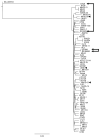Defining Fluoroquinolone Resistance-Mediating Mutations from Non-Resistance Polymorphisms in Mycoplasma hominis Topoisomerases
- PMID: 34827317
- PMCID: PMC8614649
- DOI: 10.3390/antibiotics10111379
Defining Fluoroquinolone Resistance-Mediating Mutations from Non-Resistance Polymorphisms in Mycoplasma hominis Topoisomerases
Abstract
Often dismissed as a commensal, Mycoplasma hominis is an increasingly prominent target of research due to its role in septic arthritis and organ transplant failure in immunosuppressed patients, particularly lung transplantation. As a mollicute, its highly reductive genome and structure render it refractile to most forms of treatment and growing levels of resistance to the few sources of treatment left, such as fluoroquinolones. We examined antimicrobial susceptibility (AST) to fluoroquinolones on 72 isolates and observed resistance in three (4.1%), with corresponding mutations in the quinolone resistance-determining region (QRDR) of S83L or E87G in gyrA and S81I or E85V in parC. However, there were high levels of polymorphism identified between all isolates outside of the QRDR, indicating caution for a genomics-led approach for resistance screening, particularly as we observed a further two quinolone-susceptible isolates solely containing gyrA mutation S83L. However, both isolates spontaneously developed a second spontaneous E85K parC mutation and resistance following prolonged incubation in 4 mg/L levofloxacin for an extra 24-48 h. Continued AST surveillance and investigation is required to understand how gyrA QRDR mutations predispose M. hominis to rapid spontaneous mutation and fluoroquinolone resistance, absent from other susceptible isolates. The unusually high prevalence of polymorphisms in M. hominis also warrants increased genomics' surveillance.
Keywords: Mycoplasma hominis; United Kingdom; antibiotic resistance; epidemiology; fluoroquinolone; genome analysis; genomics; topoisomerase.
Conflict of interest statement
The authors declare no conflict of interest.
Figures



References
-
- Plummer E.L., Vodstrcil L.A., Bodiyabadu K., Murray G.L., Doyle M., Latimer R.L., Fairley C.K., Payne M., Chow E.P.F., Garland S.M., et al. Are Mycoplasma hominis, Ureaplasma Urealyticum and Ureaplasma Parvum Associated with Specific Genital Symptoms and Clinical Signs in Nonpregnant Women? Clin. Infect. Dis. Off. Publ. Infect. Dis. Soc. Am. 2021;73:659–668. doi: 10.1093/cid/ciab061. - DOI - PubMed
-
- Nowbakht C., Edwards A.R., Rodriguez-Buritica D.F., Luce A.M., Doshi P.B., De Golovine A., Bynon J.S., Nigo M. Two Cases of Fatal Hyperammonemia Syndrome Due to Mycoplasma hominis and Ureaplasma Urealyticum in Immunocompromised Patients Outside Lung Transplant Recipients. Open Forum Infect. Dis. 2019;6:ofz033. doi: 10.1093/ofid/ofz033. - DOI - PMC - PubMed
-
- Smibert O.C., Wilson H.L., Sohail A., Narayanasamy S., Schultz M.B., Ballard S.A., Kwong J.C., de Boer J., Morrissey C.O., Peleg A.Y., et al. Donor-Derived Mycoplasma hominis and an Apparent Cluster of M. hominis Cases in Solid Organ Transplant Recipients. Clin. Infect. Dis. Off. Publ. Infect. Dis. Soc. Am. 2017;65:1504–1508. doi: 10.1093/cid/cix601. - DOI - PubMed
Grants and funding
LinkOut - more resources
Full Text Sources
Research Materials

